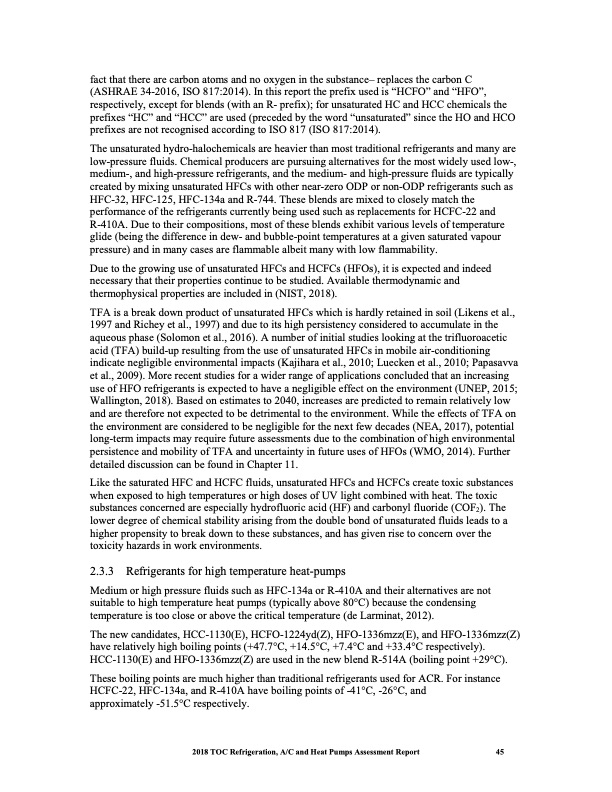
PDF Publication Title:
Text from PDF Page: 058
fact that there are carbon atoms and no oxygen in the substance– replaces the carbon C (ASHRAE 34-2016, ISO 817:2014). In this report the prefix used is “HCFO” and “HFO”, respectively, except for blends (with an R- prefix); for unsaturated HC and HCC chemicals the prefixes “HC” and “HCC” are used (preceded by the word “unsaturated” since the HO and HCO prefixes are not recognised according to ISO 817 (ISO 817:2014). The unsaturated hydro-halochemicals are heavier than most traditional refrigerants and many are low-pressure fluids. Chemical producers are pursuing alternatives for the most widely used low-, medium-, and high-pressure refrigerants, and the medium- and high-pressure fluids are typically created by mixing unsaturated HFCs with other near-zero ODP or non-ODP refrigerants such as HFC-32, HFC-125, HFC-134a and R-744. These blends are mixed to closely match the performance of the refrigerants currently being used such as replacements for HCFC-22 and R-410A. Due to their compositions, most of these blends exhibit various levels of temperature glide (being the difference in dew- and bubble-point temperatures at a given saturated vapour pressure) and in many cases are flammable albeit many with low flammability. Due to the growing use of unsaturated HFCs and HCFCs (HFOs), it is expected and indeed necessary that their properties continue to be studied. Available thermodynamic and thermophysical properties are included in (NIST, 2018). TFA is a break down product of unsaturated HFCs which is hardly retained in soil (Likens et al., 1997 and Richey et al., 1997) and due to its high persistency considered to accumulate in the aqueous phase (Solomon et al., 2016). A number of initial studies looking at the trifluoroacetic acid (TFA) build-up resulting from the use of unsaturated HFCs in mobile air-conditioning indicate negligible environmental impacts (Kajihara et al., 2010; Luecken et al., 2010; Papasavva et al., 2009). More recent studies for a wider range of applications concluded that an increasing use of HFO refrigerants is expected to have a negligible effect on the environment (UNEP, 2015; Wallington, 2018). Based on estimates to 2040, increases are predicted to remain relatively low and are therefore not expected to be detrimental to the environment. While the effects of TFA on the environment are considered to be negligible for the next few decades (NEA, 2017), potential long-term impacts may require future assessments due to the combination of high environmental persistence and mobility of TFA and uncertainty in future uses of HFOs (WMO, 2014). Further detailed discussion can be found in Chapter 11. Like the saturated HFC and HCFC fluids, unsaturated HFCs and HCFCs create toxic substances when exposed to high temperatures or high doses of UV light combined with heat. The toxic substances concerned are especially hydrofluoric acid (HF) and carbonyl fluoride (COF2). The lower degree of chemical stability arising from the double bond of unsaturated fluids leads to a higher propensity to break down to these substances, and has given rise to concern over the toxicity hazards in work environments. 2.3.3 Refrigerants for high temperature heat-pumps Medium or high pressure fluids such as HFC-134a or R-410A and their alternatives are not suitable to high temperature heat pumps (typically above 80°C) because the condensing temperature is too close or above the critical temperature (de Larminat, 2012). The new candidates, HCC-1130(E), HCFO-1224yd(Z), HFO-1336mzz(E), and HFO-1336mzz(Z) have relatively high boiling points (+47.7°C, +14.5°C, +7.4°C and +33.4°C respectively). HCC-1130(E) and HFO-1336mzz(Z) are used in the new blend R-514A (boiling point +29°C). These boiling points are much higher than traditional refrigerants used for ACR. For instance HCFC-22, HFC-134a, and R-410A have boiling points of -41°C, -26°C, and approximately -51.5°C respectively. 2018 TOC Refrigeration, A/C and Heat Pumps Assessment Report 45PDF Image | Heat Pumps Technical Options

PDF Search Title:
Heat Pumps Technical OptionsOriginal File Name Searched:
RTOC-assessment-report-2018_0.pdfDIY PDF Search: Google It | Yahoo | Bing
CO2 Organic Rankine Cycle Experimenter Platform The supercritical CO2 phase change system is both a heat pump and organic rankine cycle which can be used for those purposes and as a supercritical extractor for advanced subcritical and supercritical extraction technology. Uses include producing nanoparticles, precious metal CO2 extraction, lithium battery recycling, and other applications... More Info
Heat Pumps CO2 ORC Heat Pump System Platform More Info
| CONTACT TEL: 608-238-6001 Email: greg@infinityturbine.com | RSS | AMP |